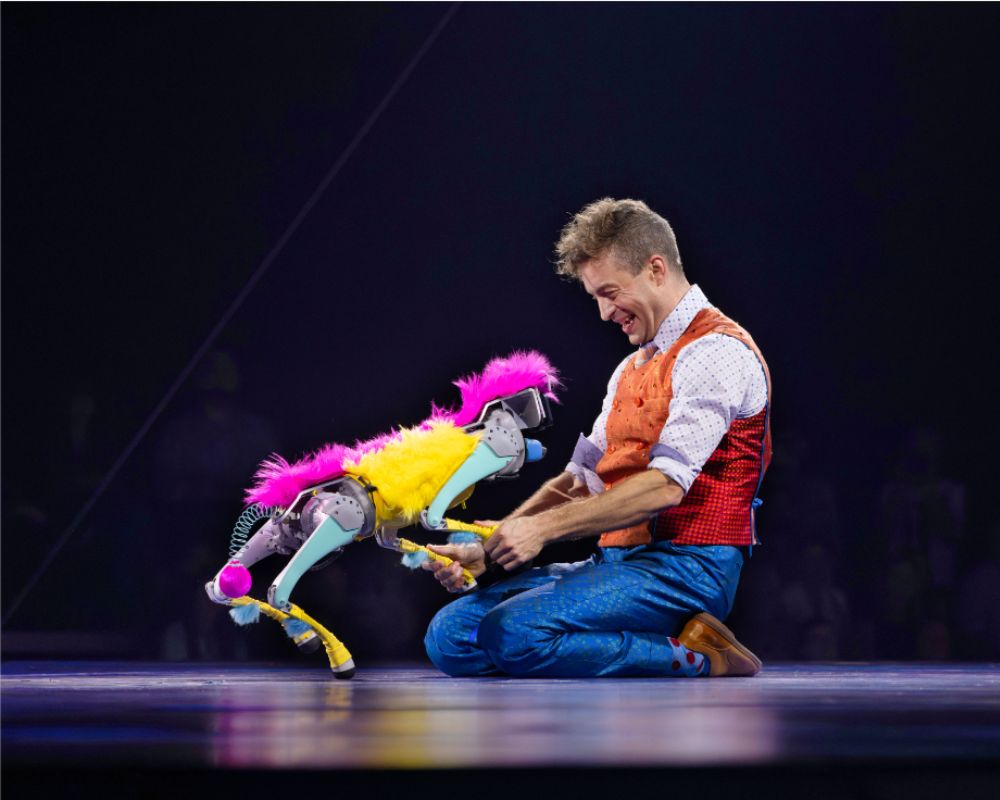First, some history. The circus swelled in popularity in the 19th century, thanks in large part to showmen P. T. Barnum, James A. Bailey and the Ringling Brothers. Irvin Feld acquired the combined Ringling Bros. and Barnum & Bailey in 1967, which means Ringling Bros. is now produced by Feld Entertainment (a company whose chairman is worth $2.7 billion). When you think “circus,” you may remember the show in its so-called golden age before its closure in 2017, when Feld halted the three-ring circus performances due in part to its long-protested animal collection.
Now, after a five-year hiatus, the “greatest show on earth” is making a comeback in cities like Baltimore and Philly, sans the live animals. The company behind it describes the show’s adoption of technology as a tool used to break down barriers between the Ringling audience and performers.
The show now includes what is suggested to be an artificial intelligence-driven “robo-dog” with a distinctive pink mohawk, as Rob Lange, the tour manager for Ringling, told Technical.ly.
“Probably the closest thing we do [have to AI] is we do have a robot dog,” he said. Her name is Bailey Circuit, or Bailey for short: “We sure think it’s got artificial intelligence because it seems awful realistic to be more than somebody running it with a joystick.”
Lange, a third-generation circus performer who describes himself as “well-rounded,” highlighted the trend of acquiring diverse skills to remain resilient in the (circus) job market. His background encompasses non-technical skills like trapeze arts and selling candy, but also technical skills such as generator maintenance and managing show lights or sound.
According to Lange, the show’s technical aspects create almost 150 roles with Ringling, spanning from the circus’ electrical department to its AV department. Technicians travel with the show from city to city. An additional 140 folks are hired locally for load-in and load-out, and about 10 of those jobs work backstage with the big top.

The show relies on a media synchronization system called Timecode, which ensures the synchronization of pyrotechnics, music, lighting and video, while allowing for manual overrides that require a human partner to accommodate the live entertainment dynamic of the reimagined show.
Ringling doesn’t have three rings anymore, but it does have over 200 feet of trussing or rigging to support the show and its use of technology, per Lange.
“The BlackTrax is an amazing system. The easiest way for me to describe it is [it’s] almost like GPS for lighting. Our performers will have two or three sensors on them, little infrared sensors,” he said about the system and its use on Ringlings’ 200-foot-long, 85-foot-wide stage. “We have 36 cameras up in the grid that read those sensors. And basically, they will triangulate where those performers are and they’ll tell the moving lights we have, ‘Hey, go left, go right, [go] here, go there and it will follow them, like spotlight operators used to do.”
Using Ringling’s long-time production software, Disguise — a platform designed for technologists to execute live visual experiences — and BlackTrax, Lange explains that each show technology is intricately programmed and manned by skilled technicians.
The combination of spatial and audio technologies follows the sounds and movements of the circus and its 75 cast members, and of course, Bailey Circuit throughout the two hours and eight minutes of the show at 50 tour stops this season. That includes CFG Bank Arena in Baltimore starting on Nov. 24 and the Wells Fargo Center in Philly starting on Feb. 17.







